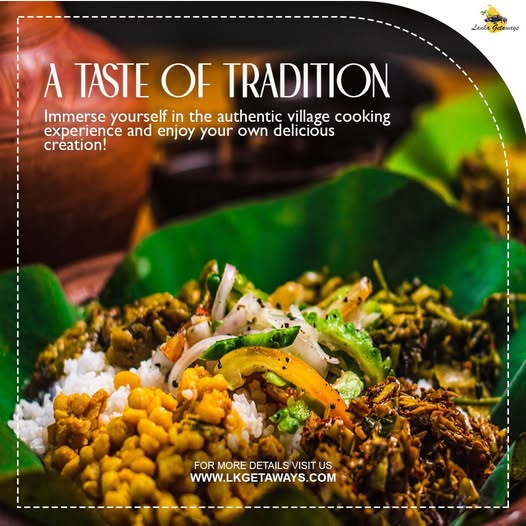Sri Lankan cuisine offers a vibrant and diverse range of flavors, textures, and aromas that reflect the island's rich history, cultural diversity, and geographic variety. Known for its unique blend of spices, fresh ingredients, and traditional cooking methods, Sri Lankan food is a feast for the senses. From aromatic curries to sweet treats, the country's food is a true reflection of its culture, traditions, and the influences of various civilizations that have shaped the island over the centuries.
In this detailed blog, we will take you on a flavorful journey through Sri Lankan food, exploring the staples, key ingredients, traditional dishes, street food, and even the cultural significance behind the meals enjoyed by locals. To make the most of your culinary journey through Sri Lanka, be sure to plan your trip with the help of LKGetaways.com, which offers curated travel packages and experiences to explore Sri Lanka's rich culture and cuisine.
The Basics of Sri Lankan Cuisine
Sri Lankan cuisine is heavily influenced by the island's geographical location in the Indian Ocean, making seafood and coconut an integral part of many dishes. The diverse climate zones, from coastal regions to fertile plains and highlands, offer a rich array of local produce, including rice, vegetables, fruits, and spices. Furthermore, Sri Lanka’s long history of trade and cultural exchanges has resulted in an eclectic blend of flavors from South Asia, Europe, the Middle East, and Southeast Asia.
Sri Lankan food is known for its bold, spicy, and aromatic flavors. The use of fresh spices such as cinnamon, cardamom, cumin, coriander, and curry leaves, combined with the natural sweetness of coconut milk and the heat of chili, creates a perfect balance of taste. Additionally, rice is a central component of Sri Lankan cuisine, often served alongside various curries, meats, and vegetables.
Key Ingredients in Sri Lankan Food
Several key ingredients form the foundation of Sri Lankan cuisine. These ingredients contribute to the distinct taste and character of the dishes, making them stand out on the global food scene.
1. Rice (Kadala)
Rice is the cornerstone of Sri Lankan meals, and it’s often served with a variety of curries, sambols (condiments), and vegetables. Sri Lankans typically consume rice for breakfast, lunch, and dinner. There are many varieties of rice grown in Sri Lanka, with red rice being the most common, known for its nutty flavor and high nutritional value.
2. Coconut (Pol)
Coconut is one of the most versatile ingredients in Sri Lankan cooking. It is used in various forms, such as fresh grated coconut (pol sambol), coconut milk, and coconut oil. Coconut milk, extracted from the flesh of grated coconut, adds creaminess to many curries and stews, while coconut oil is often used for frying. Fresh coconut is a key ingredient in both savory dishes and desserts.
3. Spices
Sri Lanka is often referred to as the "spice island" because of its rich history in the cultivation and export of spices. Cinnamon, cardamom, turmeric, cumin, coriander, fennel, and mustard seeds are just a few of the aromatic spices used extensively in Sri Lankan cooking. These spices give the food its distinctive flavor, warmth, and heat.
4. Lentils and Legumes
Lentils, peas, and beans are commonly used in Sri Lankan dishes, providing a source of protein. Dhal curry, made from yellow lentils, is a staple of Sri Lankan meals. These legumes are often cooked in rich, flavorful curry sauces, alongside vegetables or meat.
5. Chili
Sri Lankan food is known for its spiciness, and chili plays a central role in this. Fresh green chilies, dried red chilies, and chili powder are used liberally to create the signature heat in the cuisine. Sri Lankans enjoy their food hot, and it’s often paired with a cooling side dish to balance the heat.
Signature Sri Lankan Dishes
Now that we have a basic understanding of the key ingredients, let's dive into some of the most iconic dishes in Sri Lankan cuisine. From savory curries to fresh condiments and delectable desserts, Sri Lankan food offers something for every palate. If you’re planning a culinary tour of Sri Lanka, LKGetaways.com offers personalized travel experiences that can guide you through these dishes in the most authentic settings.
1. Rice and Curry (Rice & Curries)
Perhaps the most iconic dish in Sri Lanka, rice and curry is a meal that consists of a serving of rice accompanied by an array of curries. These curries can include meat (such as chicken, beef, or mutton), seafood (like fish or prawns), or vegetarian options such as dhal (lentils), eggplant, and potatoes. The curries are typically accompanied by a selection of sambols (spicy condiments) and pickles, which add an extra layer of flavor to the meal.
-
Sri Lankan Chicken Curry: Known for its rich, aromatic flavors, Sri Lankan chicken curry is prepared with a blend of spices, coconut milk, and a touch of tamarind for tartness. The chicken is slow-cooked until tender, absorbing all the spices and flavors.
-
Dhal Curry: A comforting and filling dish, dhal curry is made with yellow lentils cooked in coconut milk and seasoned with curry leaves, mustard seeds, and a hint of turmeric and cumin.
-
Fish Curry (Malu Curry): Sri Lanka, being an island nation, has an abundance of fresh seafood. Malu curry is a classic fish curry that combines fish with aromatic spices, curry leaves, and coconut milk.
2. Hoppers (Appa)
Hoppers, or appa, are a popular Sri Lankan breakfast dish. These thin, bowl-shaped pancakes are made from fermented rice flour and coconut milk, giving them a slightly tangy flavor. They are crispy on the edges and soft in the center. Egg hoppers are a variation where an egg is cracked into the center of the hopper while it’s cooking. Hoppers are typically served with sambols and curry for a complete meal. You can enjoy these in traditional local restaurants or as part of a curated culinary experience from LKGetaways.com.
3. Kottu Roti
Kottu roti is a beloved street food in Sri Lanka, made by chopping up godamba roti (a type of flatbread) and stir-frying it with vegetables, eggs, meat, and a variety of spices. The dish is cooked on a hot griddle, with the ingredients being chopped and mixed together using two metal blades, creating a unique rhythmic sound. Kottu is often enjoyed with a side of curry sauce or sambol for added flavor. This street food experience is a must-try and one that LKGetaways.com can guide you to in the bustling markets of Sri Lanka.
4. Pol Sambol
Pol sambol is a traditional Sri Lankan condiment made from grated coconut, red chili powder, onions, and a squeeze of lime. It is spicy, tangy, and flavorful, often served alongside rice and curry, hoppers, or even as a topping for bread. Pol sambol is a staple at almost every meal in Sri Lanka, and LKGetaways.com offers food tours that introduce you to authentic sambol recipes.
5. String Hoppers (Idiyappam)
String hoppers are delicate rice flour noodles steamed into small, circular shapes. These are typically served for breakfast or dinner, accompanied by curry and sambols. String hoppers are particularly popular in coastal areas and are enjoyed for their light texture and ability to absorb the rich flavors of the accompanying dishes.
6. Pittu
Pittu is another traditional Sri Lankan dish made from steamed rice flour and grated coconut, shaped into cylindrical forms. It is commonly served with a side of curry, usually dhal or meat curry. The soft, slightly dense texture of pittu makes it a comforting meal enjoyed throughout the day.
Sri Lankan Desserts
Sri Lanka also boasts an array of delicious desserts, many of which use coconut and jaggery (unrefined palm sugar) as key ingredients.
1. Watalappan
Watalappan is a rich and creamy coconut custard pudding made from coconut milk, jaggery, eggs, and a variety of spices such as cardamom and nutmeg. This dessert has a velvety texture and is often served chilled at festive occasions.
2. Kiri Toffee
Kiri toffee is a traditional Sri Lankan sweet made from condensed milk, sugar, and coconut. It has a chewy, caramelized texture that makes it incredibly indulgent. The toffee is typically cut into small squares and enjoyed as a treat.
3. Coconut Laddoo
Coconut laddoo (also known as coconut balls) is a sweet made from grated coconut, sugar, and sometimes condensed milk. These bite-sized treats are perfect for satisfying your sweet tooth after a savory meal.
4. Faluda
A popular dessert drink, faluda is a refreshing mix of rose syrup, milk, basil seeds, and ice cream, often topped with jelly or fruits. It’s a popular choice during the hot months in Sri Lanka and is enjoyed by both locals and visitors alike.
Street Food in Sri Lanka
Sri Lanka’s street food scene is vibrant, and travelers will find an endless array of tasty snacks and quick bites available throughout the island. Some popular street foods include:
- Samosas: Fried pastry pockets filled with spiced potatoes, peas, and sometimes meat, samosas are a favorite snack for locals and tourists.
- Seeni Sambol Bun: A sweet and spicy bun filled with caramelized onions (seeni sambol), which is a popular treat sold by street vendors.
- Isso Vadei: Deep-fried lentil patties topped with prawns, this is a favorite street snack along the coasts.
To explore the best of Sri Lanka’s street food culture, check out LKGetaways.com for curated food tours that will take you to the most authentic street food stalls.
Conclusion
Sri Lankan food is a culinary adventure that promises to engage all the senses. With its unique blend of spices, fresh ingredients, and bold flavors, Sri Lankan cuisine offers a rich tapestry of traditional dishes that will leave you craving more. Whether it’s a simple meal of rice and curry, the aromatic taste of hoppers, or the sweetness of watalappan, each dish tells a story of the island's cultural heritage and its rich history of trade, agriculture, and tradition.
As you explore the island’s many regions, make sure to indulge in Sri Lanka’s culinary offerings, both in fine dining establishments and on the vibrant streets, where the local flavors come to life. LKGetaways.com can help you plan a truly immersive culinary journey through Sri Lanka, making your travel experience as flavorful and unforgettable as the food itself.



